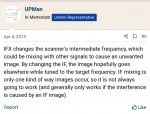Filters are definitely for troubleshooting. It is not necessary to apply filters to every object.
Some believe that the sds100 was introduced a little bit early secondary to a vendor releasing information on its existence and Whistler making the announcement that they were making a simulcast capable radio which of course we know they never did.
There were problems when the radio first came out. Uniden got out in front of the short battery life right away. They offered a free larger battery to every existing owner that had a small battery. They produced the larger battery door creating the big butt version.
Another issue was clipped, missed transmissions or skipped transmissions on Phase ll simulcast systems. My hometown system had that issue, I stopped using the SDS 100 and put it in a drawer and went back to my Mot gear hoping that a solution would be found as Paul was putting out new firmware regularly. The radio was a work in progress.
The first set of filters offered in a firmware update where normal which is default, invert and Auto. It was quickly discovered that Auto slowed scanning way down as it sampled each filter. There was an uproar for about 3 or 4 days that an option should be added to have no filter at all and it was. The second set of filters came out which were wide normal, wide invert and Wide Auto.
Global filters are used just to sample what filter is best and it's adjusted on the radio for real time observation of results. When Improvement is found Global is put back on default or normal as Global affects every object in the radio and you don't want to compromise reception on most objects normal works fine on. You then drill down to site options and apply the best filter from your sampling to each site, hopefully you only use one or two sites. I have seen cases where invert was better on one site of a system and wide invert was better on another. I was amazed that invert fixed the problem with my system, no more clipped transmissions or missed or skipped transmissions. When wide invert came out it got even better and reception was improved.
Applying filters to Conventional objects is trickier because you have to wait for a transmission to assess RSSI and noise levels, of course error rates do not apply as an indicator. Some claim that RSSI should not be used and just noise level, I use both. Also you cannot apply a filter to a single Channel. Once you sample filters on Global and find an improvement on a conventional object and you return Global to normal, you have to go to Department options that the frequency is under and change the filter there which will affect all of the frequencies in that department, not usually a problem the way conventional frequencies can be grouped.
It does take effort and time but you really can improve the performance of the radio especially with VHF, UHF and Aviation that we hear complaints about.
If you do it right and take the time it will improve overall performance of the radio. It's a good idea to add the filter indicator to your display. Don't forget, after you make changes on the radio itself using real-time results you must go to Sentinel and first thing you do is transfer the data from your card to your profile so as to permanently keep any changes you made on the radio. My explanation in the thread above is more detailed and step by step.
As far as the technicalities and how filters work, I personally believe in the kiss principal.
Also don't forget to try function 7, IFX makes a difference in some cases... What is IFX? Let's let the man himself tell you, RIP Paul.




